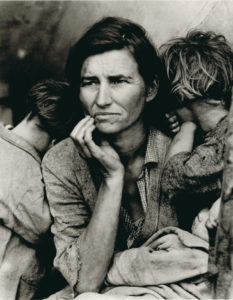Dorothea Lange’s America
Adtran, Jurenko & Thurber Galleries
May 15 – August 7, 2022

Dorothea Lange, Migrant Mother, Nipomo, California, 1936, 23 x 18 in.

Dorothea Lange, Funeral cortege, end of an era in a small valley town, California, 1938, 7.75 x 7.5 in.
Dorothea Lange’s America is a focused exhibition of 30 original lifetime prints by the legendary documentary photographer, Dorothea Lange (1895-1965). Her empathetic images of migrant workers, suffering families, and tortured landscapes seared the faces of the Great Depression into America’s consciousness. Her most celebrated photographs of that era have become icons in American cultural history. The exhibition surveys the arc of Lange’s career with images dating from 1929 to 1964, and is supplemented with 25 photographs by 11 other notable social documentarians of the era, including Walker Evans, Ben Shahn, Doris Ulmann, Russell Lee, and Mike Disfarmer. Each used their cameras and the power of photography to effect positive change.
Lange herself had known adversity early in life. At age 7 she was stricken with polio, which left her with a lifetime limp. And at age 12 her father disappeared from the scene, leaving an impoverished household behind. Every day she would ride the ferry with her mother from Hoboken, New Jersey to lower Manhattan, to a roiling working-class neighborhood teeming with immigrants. During that period, Lange talked her way into photo courses with a range of teachers as diverse as Arnold Genthe and Clarence White. In 1918 she moved to San Francisco where she befriended photographers Ansel Adams and Imogen Cunningham, and, through them, the celebrated Western painter Maynard Dixon, who became her first husband. She soon opened a thriving portrait studio that catered to San Francisco’s professional class and monied elite. But with the crash of 1929, Lange found her true calling, as a peripatetic chronicler of the many faces of America as they dealt with unprecedented hardship, sometimes with resilience, often with despondence. Lange’s working method was gentle, open, and personal. She engaged her photographic subjects in conversation, winning their confidence and their consent to be photographed. Ironically, her limp, which marked her as someone who had suffered in her own way, helped her to disarm and bond with her subjects. Lange’s pictures typically focus on a single figure even amidst a crowd shot. And work—its presence or absence—is a constant theme, connected, perhaps, to a frequent emphasis on people’s hands.
The importance of Lange’s Depression-era work was recognized almost immediately, and led to a long and fruitful collaboration with the New Deal’s Farm Security Administration (FSA). After World War II, she was the first woman photographer awarded a Guggenheim fellowship, helped found Aperture magazine, and was honored by the Museum of Modern Art with a career retrospective. Her most important achievement, however, is that her Depression-era work served in a real way to alleviate the suffering of the very people she chronicled: it raised public awareness of the dire need for federal assistance around the country, and helped convince Congress to provide it.
Drawn from the private collection of Michael Mattis and Judith Hochberg, Dorothea Lange’s America has been organized by art2art Circulating Exhibitions.
Thank you, Sponsors!
Sponsors:
Samia Spencer
Media Sponsor:

Additional Support:
The Alabama State Council on the Arts
The Huntsville Museum of Art Guild

